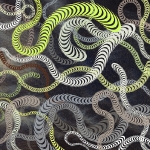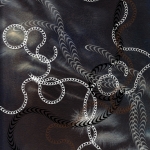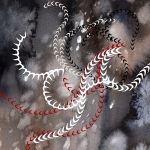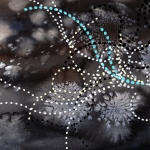
Sophia Brueckner is a West Coast artist I’ve profiled before, but given the dramatic evolution of her recent work (see left and below), I’m taking the opportunity to once again share her work. Her new pieces are distinguished by their emphasis on repetition and patterns and their degree of abstraction. Brueckner refers to these new paintings as generative, meaning that they are partly executed by computer algorithms the artist creates using javascript. As it turns out, this is not an unexpected development for Brueckner who has a background in math and computer science and previously worked as a software engineer.
As Sophia states in the interview, this is an artistic process that she is dedicated to and excited to explore, and similarly we are excited to watch Brueckner’s work develop and flourish.
HA: What inspired you to take this new direction in generative art?
SB: I’ve always been interested in science, technology, and math. My degree is actually in computer science and applied math and I worked as a software engineer for a few years before making the decision to pursue full time. I’m fascinated by growth in nature. An algorithm is a computer science term for a set of steps to accomplishing a task. The growth in any living thing is governed by an algorithm…the way a plant grows new branches and multiplies, the way different living things respond to competition and limited resources, etc. When I look at nature, I think about how to break up the complex patterns of growth into simple steps and recreate it with a computer. I like taking a very simple shape and then using algorithms to grow more complex shapes and patterns.
HA: What do Photoshop and Java allow you to achieve artistically that otherwise wouldn’t be possible?
SB: Working with the computer is refreshingly forgiving. Anything can be undone which makes it wonderful for experimenting and taking risks. This is the exact opposite of what is like when I paint in watercolor. Watercolor is very unforgiving and making a mistake often means starting over. The instant gratification of being able to change the color of something or change its position is also wonderful. It’s nice to experiment with the computer and then apply what I learned in terms of color and composition to my watercolor paintings. Working with the computer has created an unexpected feedback loop of inspiration. What I paint by hand influences what I ask the computer to do, and what the computer generates influences how I paint by hand.
HA: Was your process very different in this series?
SB: I like to think that I used the computer to automate the way I paint by hand. Automating repetitive tasks is always the goal of a good software engineer, and this way of thinking must have crept into my artwork. When I paint by hand, I place a shape almost randomly, like a seed that has fallen somewhere. Then my intuition tells me what the rules are for its growth, where it is possible for the next shape to go. As I respond these rules within the work, the shapes grow into a pattern like an organism. This is exactly what I do with my generative work as well. I place the initial shape and then grow it according to the rules defined in a computer program.
HA: Do you think you’ll continue to use these tools in future work?
SB: Definitely! I feel like I’ve just barely even started! I want to create more complex programs to make these images…the possibilities feel endless. The computer also opens up an entirely new dimension to painting by allowing me to create work that changes over time and is animated and interactive. My next step will be to create dynamic, alive paintings that eventually will respond somehow to the viewer. It is possible to incorporate randomness into a dynamic painting such that it is never exactly the same twice. But the fascinating challenge would be to create work that is always moving and different but is still beautiful and intentional. I’d love to explore this balance!
HA: Your work has a strong organic quality, but your generative work is more graphic and abstract. Do you see yourself moving away from the more figurative, natural elements of your earlier work?
SB: Actually, my hope would be to learn how to bring the strong, organic quality of my watercolor paintings into my work using the computer. Art generated by a computer usually looks as if it is done by a computer, but I want my generative work to feel like a great painting. My long term goal is to create generative work that is like what I do in my watercolor paintings but is alive, interactive, and always changing.






5 responses so far ↓
1 sophia // Nov 4, 2009 at 11:47 pm
thanks so much for this interview! 🙂
2 Kate // Nov 5, 2009 at 3:03 pm
You’re very welcome!
3 Chris Rywalt // Nov 12, 2009 at 12:32 pm
Sophia’s work looks pretty excellent. It reminds me of some of my own abstract work, which is generative but doesn’t involve a computer. I trained as an engineer, also, with a degree in computer science, and worked as a programmer for years. I’ve resisted using the computer in my art, however.
4 Amy // Dec 28, 2014 at 10:56 am
Eseis, paidia, xteere polla pou emena den me endiaferoun. Egw lew oti den prepei na yparxei fanatismos kai h epistolh toy Katholikou ths Syrou mou arese. Einai s’ auto to pneuma.
5 auto insurance quotes MT // Apr 1, 2015 at 11:21 am
Also, why didn’t the NFL use head to head originally? The Giants tied for first with the Redskins in ’43 and Cleveland in ’50 having beaten both teams both times head to head. Yet, both times lost a tiebreaker game. What was the rationale for not having head to head be the tie breaker?
Leave a Comment